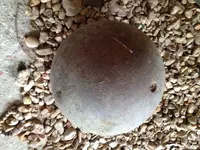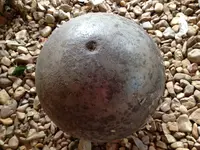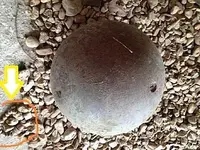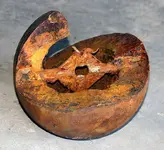First... EXCAVATED cannon BALLS are not dangerous to merely handle, or drop, or even to hammer on. Please note I said BALLS -- bullet-shaped artillery shells from the 20th-Century can still be dangerous to drop.
The evidence:
We relic-hunters have dug up ("excavated") more than 50,000 cannonBALLS -- and nearly every one of those got hit by the shovel during the digging process. Also, relic-diggers are notorious for cleaning the rust-encrustation off dug cannonballs by bashing them with a hammer. Extensive research of newspaper archives indicates that not even one cannonBALL explosion has been reported to have happened during digging-up... or even during hammer-bashing. But remember, I'm talking bout cannon BALLS.
The only two ways to make an EXCAVATED cannonBALL explode are:
1- drill into it
2- heat it to above 572-degrees Fahrenheit (which is the ignition-temperature of the blackpowder explosive charge in cannonballs).
If you avoid doing those two extremely "provocative" things, an EXCAVATED cannonBALL is safe to handle.
The reason the police tell the public that EVERY cannon projectile is deadly is that most people (including most policemen) cannot tell the difference between a dangerous 20th-Century artillery projectile and a comparatively harmless pre-1880 artillery projectile. For example, to un-educated eyes, a bullet-shaped civil war (1861-1865) Parrott's-Patent artillery shell and a World War 2 shell can look very similar.
Now, about the 100-pound ball posted by Ccdog:
I've personally examined these 4-tiny-holes balls several times. I am 100%-certain it is not a cannonball, for the following reasons.
1- No cannonballs had four tiny holes.
2- MOST importantly, none of these are the precisely-correct diameter to fit any known caliber of cannons.
3- These are made of steel, and there were no steel explosive cannonBALLS in Artillery history.
4- None of the 4-tiny-holes balls have ever been excavated from a battlefield. In fact, the majority of the few known specimens of them have been found at scrapyards in the late 20th-Century.

We Historical Artillery scholars have not discovered the identity of these 4-tiny-holes steel balls, but they are definitely not cannonballs.
Anybody here who wants to know my Professional Qualifications for making all of the above statements can check the "About me" section in my TreasureNet profile. And, yes, I wrote the encyclopedic reference-book on civil war artillery projectiles mentioned by HutSiteDigger in post #7 in this discussion-thread. Also, I co-authored the Solid Shot Essentials educational article here:
SolidShotEssentialsMod







